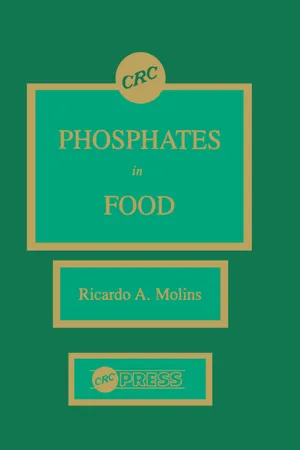
- 272 pages
- English
- ePUB (mobile friendly)
- Available on iOS & Android
Phosphates in Food
About this book
Phosphates in Food provides the first comprehensive analysis of phosphates used in food processing in almost 20 years. The book describes the nomenclature, structure, chemistry, and analytical procedures for phosphates in foods. Interactions between added and some natural phosphates and food components (particularly proteins, carbohydrates, lipids, and metal ions) are examined in relation to using phosphates in food processing for such purposes as increasing the water-holding capacity of proteins, improving emulsification, preventing gelation, and delaying lipid oxidation. The book also discusses the use of phosphates in specific food groups, such as milk and dairy products; meats, poultry, and fish; fruits and vegetables; bakery products and cereals; and miscellaneous food products including beverages, fats and oils, sugar and confectionery products, eggs and derivatives, and specialty products. An extensive section discussing the importance of phosphates as microbial agents is presented and is followed by a final section that examines the nutritional and health implications of elevated phosphate intake. The book contains 1, 135 references, 43 tables, and 34 figures, making it an ideal reference resource for researchers in food sciences, microbiology, and nutrition; food and chemical industries; and regulatory agencies within local, state, and federal governments.
Frequently asked questions
- Essential is ideal for learners and professionals who enjoy exploring a wide range of subjects. Access the Essential Library with 800,000+ trusted titles and best-sellers across business, personal growth, and the humanities. Includes unlimited reading time and Standard Read Aloud voice.
- Complete: Perfect for advanced learners and researchers needing full, unrestricted access. Unlock 1.4M+ books across hundreds of subjects, including academic and specialized titles. The Complete Plan also includes advanced features like Premium Read Aloud and Research Assistant.
Please note we cannot support devices running on iOS 13 and Android 7 or earlier. Learn more about using the app.
Information
Table of contents
- Cover
- Title Page
- Copyright Page
- Dedication
- Table of Contents
- Chapter 1 Introduction: Phosphates and Phosphorous Compounds in Foods
- Chapter 2 The Chemistry of Phosphates in Foods
- Chapter 3 Interactions Between Phosphates and Food Components
- Chapter 4 Phosphates in Milk and Dairy Products
- Chapter 5 Phosphates in Muscle Foods
- Chapter 6 Phosphates in Cereals and Bakery Products
- Chapter 7 Phosphates in Vegetables, Legumes, Fruits, and Derivatives
- Chapter 8 Applications of Phosphates in Miscellaneous Foods and Beverages
- Chapter 9 Antimicrobial Uses of Food Phosphates
- Chapter 10 Nutritional and Toxicological Aspects of Natural and Added Phosphates in Foods and Feeds
- Index